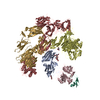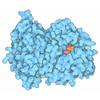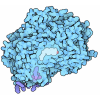[English] 日本語
 Yorodumi
Yorodumi- PDB-8eok: Structure of the C3bB proconvertase in complex with lufaxin and f... -
+ Open data
Open data
- Basic information
Basic information
| Entry | Database: PDB / ID: 8eok | ||||||
|---|---|---|---|---|---|---|---|
| Title | Structure of the C3bB proconvertase in complex with lufaxin and factor Xa | ||||||
 Components Components |
| ||||||
 Keywords Keywords | IMMUNE SYSTEM / Complement / Alternative pathway / inhibitor / sand fly | ||||||
| Function / homology |  Function and homology information Function and homology informationalternative-complement-pathway C3/C5 convertase / C5L2 anaphylatoxin chemotactic receptor binding / oviduct epithelium development / regulation of triglyceride biosynthetic process / complement binding / positive regulation of activation of membrane attack complex / vertebrate eye-specific patterning / positive regulation of apoptotic cell clearance / complement-mediated synapse pruning / Alternative complement activation ...alternative-complement-pathway C3/C5 convertase / C5L2 anaphylatoxin chemotactic receptor binding / oviduct epithelium development / regulation of triglyceride biosynthetic process / complement binding / positive regulation of activation of membrane attack complex / vertebrate eye-specific patterning / positive regulation of apoptotic cell clearance / complement-mediated synapse pruning / Alternative complement activation / coagulation factor Xa / positive regulation of phagocytosis, engulfment / Activation of C3 and C5 / positive regulation of lipid storage / positive regulation of G protein-coupled receptor signaling pathway / positive regulation of type IIa hypersensitivity / complement receptor mediated signaling pathway / Defective factor IX causes thrombophilia / Defective cofactor function of FVIIIa variant / Defective F9 variant does not activate FX / complement-dependent cytotoxicity / positive regulation of D-glucose transmembrane transport / complement activation / complement activation, alternative pathway / Extrinsic Pathway of Fibrin Clot Formation / endopeptidase inhibitor activity / neuron remodeling / amyloid-beta clearance / B cell activation / positive regulation of vascular endothelial growth factor production / complement activation, classical pathway / positive regulation of TOR signaling / Transport of gamma-carboxylated protein precursors from the endoplasmic reticulum to the Golgi apparatus / Gamma-carboxylation of protein precursors / Common Pathway of Fibrin Clot Formation / Removal of aminoterminal propeptides from gamma-carboxylated proteins / Purinergic signaling in leishmaniasis infection / Intrinsic Pathway of Fibrin Clot Formation / Peptide ligand-binding receptors / Regulation of Complement cascade / Post-translational protein phosphorylation / response to bacterium / fatty acid metabolic process / phospholipid binding / positive regulation of receptor-mediated endocytosis / Golgi lumen / Regulation of Insulin-like Growth Factor (IGF) transport and uptake by Insulin-like Growth Factor Binding Proteins (IGFBPs) / positive regulation of angiogenesis / Immunoregulatory interactions between a Lymphoid and a non-Lymphoid cell / positive regulation of protein phosphorylation / blood coagulation / azurophil granule lumen / toxin activity / secretory granule lumen / blood microparticle / G alpha (i) signalling events / immune response / positive regulation of cell migration / receptor ligand activity / G protein-coupled receptor signaling pathway / endoplasmic reticulum lumen / inflammatory response / signaling receptor binding / external side of plasma membrane / serine-type endopeptidase activity / calcium ion binding / Neutrophil degranulation / cell surface / signal transduction / protein-containing complex / proteolysis / extracellular space / extracellular exosome / extracellular region / plasma membrane Similarity search - Function | ||||||
| Biological species |  Lutzomyia longipalpis (insect) Lutzomyia longipalpis (insect) Homo sapiens (human) Homo sapiens (human) | ||||||
| Method | ELECTRON MICROSCOPY / single particle reconstruction / cryo EM / Resolution: 3.53 Å | ||||||
 Authors Authors | Andersen, J.F. / Lei, H. | ||||||
| Funding support |  United States, 1items United States, 1items
| ||||||
 Citation Citation |  Journal: Blood / Year: 2023 Journal: Blood / Year: 2023Title: A bispecific inhibitor of complement and coagulation blocks activation in complementopathy models via a novel mechanism. Authors: John F Andersen / Haotian Lei / Ethan C Strayer / Tapan Kanai / Van Pham / Xiang-Zuo Pan / Patricia Hessab Alvarenga / Gloria F Gerber / Oluwatoyin A Asojo / Ivo M B Francischetti / Robert A ...Authors: John F Andersen / Haotian Lei / Ethan C Strayer / Tapan Kanai / Van Pham / Xiang-Zuo Pan / Patricia Hessab Alvarenga / Gloria F Gerber / Oluwatoyin A Asojo / Ivo M B Francischetti / Robert A Brodsky / Jesus G Valenzuela / José M C Ribeiro /  Abstract: Inhibitors of complement and coagulation are present in the saliva of a variety of blood-feeding arthropods that transmit parasitic and viral pathogens. Here, we describe the structure and mechanism ...Inhibitors of complement and coagulation are present in the saliva of a variety of blood-feeding arthropods that transmit parasitic and viral pathogens. Here, we describe the structure and mechanism of action of the sand fly salivary protein lufaxin, which inhibits the formation of the central alternative C3 convertase (C3bBb) and inhibits coagulation factor Xa (fXa). Surface plasmon resonance experiments show that lufaxin stabilizes the binding of serine protease factor B (FB) to C3b but does not detectably bind either C3b or FB alone. The crystal structure of the inhibitor reveals a novel all β-sheet fold containing 2 domains. A structure of the lufaxin-C3bB complex obtained via cryo-electron microscopy (EM) shows that lufaxin binds via its N-terminal domain at an interface containing elements of both C3b and FB. By occupying this spot, the inhibitor locks FB into a closed conformation in which proteolytic activation of FB by FD cannot occur. C3bB-bound lufaxin binds fXa at a separate site in its C-terminal domain. In the cryo-EM structure of a C3bB-lufaxin-fXa complex, the inhibitor binds to both targets simultaneously, and lufaxin inhibits fXa through substrate-like binding of a C-terminal peptide at the active site as well as other interactions in this region. Lufaxin inhibits complement activation in ex vivo models of atypical hemolytic uremic syndrome (aHUS) and paroxysmal nocturnal hemoglobinuria (PNH) as well as thrombin generation in plasma, providing a rationale for the development of a bispecific inhibitor to treat complement-related diseases in which thrombosis is a prominent manifestation. | ||||||
| History |
|
- Structure visualization
Structure visualization
| Structure viewer | Molecule:  Molmil Molmil Jmol/JSmol Jmol/JSmol |
|---|
- Downloads & links
Downloads & links
- Download
Download
| PDBx/mmCIF format |  8eok.cif.gz 8eok.cif.gz | 513 KB | Display |  PDBx/mmCIF format PDBx/mmCIF format |
|---|---|---|---|---|
| PDB format |  pdb8eok.ent.gz pdb8eok.ent.gz | 405.5 KB | Display |  PDB format PDB format |
| PDBx/mmJSON format |  8eok.json.gz 8eok.json.gz | Tree view |  PDBx/mmJSON format PDBx/mmJSON format | |
| Others |  Other downloads Other downloads |
-Validation report
| Summary document |  8eok_validation.pdf.gz 8eok_validation.pdf.gz | 1.4 MB | Display |  wwPDB validaton report wwPDB validaton report |
|---|---|---|---|---|
| Full document |  8eok_full_validation.pdf.gz 8eok_full_validation.pdf.gz | 1.4 MB | Display | |
| Data in XML |  8eok_validation.xml.gz 8eok_validation.xml.gz | 80.8 KB | Display | |
| Data in CIF |  8eok_validation.cif.gz 8eok_validation.cif.gz | 120.4 KB | Display | |
| Arichive directory |  https://data.pdbj.org/pub/pdb/validation_reports/eo/8eok https://data.pdbj.org/pub/pdb/validation_reports/eo/8eok ftp://data.pdbj.org/pub/pdb/validation_reports/eo/8eok ftp://data.pdbj.org/pub/pdb/validation_reports/eo/8eok | HTTPS FTP |
-Related structure data
| Related structure data |  28378MC  8enuC  8eo2C M: map data used to model this data C: citing same article ( |
|---|---|
| Similar structure data | Similarity search - Function & homology  F&H Search F&H Search |
- Links
Links
- Assembly
Assembly
| Deposited unit | 
|
|---|---|
| 1 |
|
- Components
Components
-Protein , 6 types, 6 molecules GHDALC
| #1: Protein | Mass: 71393.320 Da / Num. of mol.: 1 / Source method: isolated from a natural source / Source: (natural)  Homo sapiens (human) / References: UniProt: P01024 Homo sapiens (human) / References: UniProt: P01024 |
|---|---|
| #2: Protein | Mass: 104073.164 Da / Num. of mol.: 1 / Source method: isolated from a natural source / Source: (natural)  Homo sapiens (human) / References: UniProt: P01024 Homo sapiens (human) / References: UniProt: P01024 |
| #3: Protein | Mass: 85510.617 Da / Num. of mol.: 1 / Source method: isolated from a natural source / Source: (natural)  Homo sapiens (human) Homo sapiens (human)References: UniProt: P00751, alternative-complement-pathway C3/C5 convertase |
| #4: Protein | Mass: 33354.586 Da / Num. of mol.: 1 Source method: isolated from a genetically manipulated source Source: (gene. exp.)  Lutzomyia longipalpis (insect) / Cell line (production host): HEK293 / Production host: Lutzomyia longipalpis (insect) / Cell line (production host): HEK293 / Production host:  Homo sapiens (human) / References: UniProt: Q5WPU8 Homo sapiens (human) / References: UniProt: Q5WPU8 |
| #5: Protein | Mass: 15210.793 Da / Num. of mol.: 1 / Source method: isolated from a natural source / Source: (natural)  Homo sapiens (human) / References: UniProt: P00742 Homo sapiens (human) / References: UniProt: P00742 |
| #6: Protein | Mass: 28550.596 Da / Num. of mol.: 1 / Source method: isolated from a natural source / Source: (natural)  Homo sapiens (human) / References: UniProt: P00742 Homo sapiens (human) / References: UniProt: P00742 |
-Sugars , 2 types, 3 molecules 
| #7: Polysaccharide | beta-D-mannopyranose-(1-4)-2-acetamido-2-deoxy-beta-D-glucopyranose-(1-4)-2-acetamido-2-deoxy-beta- ...beta-D-mannopyranose-(1-4)-2-acetamido-2-deoxy-beta-D-glucopyranose-(1-4)-2-acetamido-2-deoxy-beta-D-glucopyranose Source method: isolated from a genetically manipulated source |
|---|---|
| #9: Sugar |
-Non-polymers , 1 types, 1 molecules 
| #8: Chemical | ChemComp-MG / |
|---|
-Details
| Has ligand of interest | N |
|---|---|
| Has protein modification | Y |
-Experimental details
-Experiment
| Experiment | Method: ELECTRON MICROSCOPY |
|---|---|
| EM experiment | Aggregation state: PARTICLE / 3D reconstruction method: single particle reconstruction |
- Sample preparation
Sample preparation
| Component | Name: The C3 proconvertase from the alternative pathway of complement in complex with lufaxin, a complement/coagulation inhibitor and coagulation factor Xa Type: COMPLEX / Entity ID: #1-#3, #5-#6 / Source: MULTIPLE SOURCES | ||||||||||||||||||||
|---|---|---|---|---|---|---|---|---|---|---|---|---|---|---|---|---|---|---|---|---|---|
| Molecular weight | Value: 0.3483 MDa / Experimental value: YES | ||||||||||||||||||||
| Source (natural) | Organism:  Homo sapiens (human) Homo sapiens (human) | ||||||||||||||||||||
| Source (recombinant) | Organism:  Homo sapiens (human) / Cell: HEK 293 / Plasmid: VR2001 Homo sapiens (human) / Cell: HEK 293 / Plasmid: VR2001 | ||||||||||||||||||||
| Buffer solution | pH: 7.5 | ||||||||||||||||||||
| Buffer component |
| ||||||||||||||||||||
| Specimen | Conc.: 1.5 mg/ml / Embedding applied: NO / Shadowing applied: NO / Staining applied: NO / Vitrification applied: YES / Details: The sample was monodisperse | ||||||||||||||||||||
| Specimen support | Grid material: GOLD / Grid type: C-flat-1.2/1.3 | ||||||||||||||||||||
| Vitrification | Cryogen name: ETHANE |
- Electron microscopy imaging
Electron microscopy imaging
| Microscopy | Model: TFS GLACIOS |
|---|---|
| Electron gun | Electron source:  FIELD EMISSION GUN / Accelerating voltage: 200 kV / Illumination mode: FLOOD BEAM FIELD EMISSION GUN / Accelerating voltage: 200 kV / Illumination mode: FLOOD BEAM |
| Electron lens | Mode: BRIGHT FIELD / Nominal magnification: 45000 X / Nominal defocus max: 2200 nm / Nominal defocus min: 300 nm |
| Image recording | Electron dose: 58.31 e/Å2 / Film or detector model: GATAN K3 (6k x 4k) |
- Processing
Processing
| EM software |
| ||||||||||||||||||||||||
|---|---|---|---|---|---|---|---|---|---|---|---|---|---|---|---|---|---|---|---|---|---|---|---|---|---|
| CTF correction | Type: PHASE FLIPPING AND AMPLITUDE CORRECTION | ||||||||||||||||||||||||
| Particle selection | Num. of particles selected: 713201 | ||||||||||||||||||||||||
| 3D reconstruction | Resolution: 3.53 Å / Resolution method: FSC 0.143 CUT-OFF / Num. of particles: 248281 / Symmetry type: POINT |
 Movie
Movie Controller
Controller



 PDBj
PDBj


























